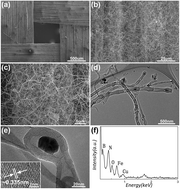Microstructure, mechanical properties and oxidation resistance of SiCf/SiC composites incorporated with boron nitride nanotubes
Abstract
SiCf/BNNTs–SiC hierarchical composites were fabricated via firstly in situ growth of boron nitride nanotubes (BNNTs) on the surface of silicon carbide (SiC) fibers using boron powder as a raw material and subsequently matrix densification by chemical vapor infiltration (CVI) and polymer impregnation/pyrolysis (PIP) methods. With the incorporation of BNNTs, energy dissipation mechanisms at the nanoscale triggered by BNNTs such as pullout, debonding, crack deflection and crack bridging are observed. But the positive effect of BNNTs on mechanical properties have not been raised due to the offset from the negative effect of pores in composites. Additionally, the residual boron powder results in an improved oxidation resistance and parabolic oxidation kinetics of SiCf/SiC composites at 900 °C, thanks to the protective effect of the B2O3 glassy phase formed by the oxidation of boron. Consequently, a better strength retention after oxidation is obtained. Moreover, it is believed that the remaining strengthening and toughening mechanisms aroused by BNNTs surviving after oxidation probably also make a contribution to the better strength retention.


 Please wait while we load your content...
Please wait while we load your content...